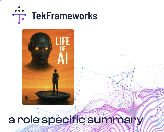Home About DeeperInsights DeeperHacks Privacy Policy
DeeperInsights for Leaders
Welcome to DeeperInsights for Leaders — a dedicated space for business leaders who want to understand AI without the noise.

AI is rapidly evolving from a futuristic concept to a driving force in business, transforming industries and reshaping how organizations operate. From automating routine tasks to enabling data-driven decision-making, AI holds immense potential to increase efficiency, innovation, and competitive advantage.
However, ironically, as AI technology improves, companies are becoming worse at harnessing the amazing power of AI as the adjacent graph illustrates.

Why do Leaders Struggle to Turn AI's Potential into Real Results?
The root causes are both strategic and cultural: unclear business alignment, immature data ecosystems, overreliance on vendors, and underinvestment in internal capabilities. AI is often treated as a technology rather than a core enabler of transformation. Without clear use-case selection, measurable outcomes, andintegration into workflows, leadership interest fades and momentum is lost.
DeeperInsights breaks down why leaders struggle with AI and how they may succeed at making the most out of AI in short, easy-to-digest episodes.
 Even as AI technology is advancing rapidly, most AI prototypes are not becoming products and most AI products are not useful. In this 7-part video series, we explain why the success rate for AI projects is abysmally low and introduce a handy framework for organizations to assess whether they are using AI in the most effective manner possible. | ||
|
AI's Success Gap Video 1 breaks down the startling statistic that only 10% of AI projects are successful. | ||
|
AI Prototype in Minutes In video 2, we demonstrate how to easily build an AI prototype in just a few minutes. | ||
|
Prototype or Pro(duct)? In video 3, we draw up a handy list of characteristics to distinguish between AI prototypes and AI products. | ||
|
DARWIN Video 4 introduces DARWIN, a framework for organizations to determine how effective their AI implementation is.  What frameworks do you use—or wish you had—to evaluate the effectiveness of AI implementation in your organization? Please share your ideas and experiences here. | ||
|
Why AI Fails : Complementary Gaps In video 5, we learn why AI projects are actually failing. It is not because the technology is rudimentary or faulty. It is because the Law of Demand for Complementary Goods in AI transforms the entire AI landscape as AI technology advances necessitating advances in fields such as testing and economics complementary to AI. | ||
|
Testing : AI's Weak Link Video 6 demonstrates how the Law of Demand for Complementary Goods in AI applies to the field of testing. | ||
|
Cost(s) of AI Video 7 examines whether it is economical to use AI and how the Law of Demand for Complementary Goods in AI affects the economics of AI. | ||
|
| ||
|
Agents Shaken Not Stirred | ||
 As large language models flood the market, businesses are racing to adopt them—often obsessing over which model to choose. In this 4-part video series, we explain why the real differentiator isn’t the model itself, but the ecosystem of tools and constraints around it. While LLMs are powerful, they are also expensive, highly creative, and easily misled—making them risky when used without focus. This series teaches leaders to cut through the hype and use LLMs wisely: for narrow tasks, with tight guardrails, and with strategic intent. | ||
|
LLM Question That Doesn't Matter Video 1 explores why the specific choice of LLM matters less than most think, highlighting how today’s leading models share broadly similar capabilities. | ||
|
Gadgets Make Agents Video 2 reveals that what makes an LLM powerful is not in the model itself, but the tools and infrastructure organizations provide. Thanks to the emergence of MCPs, organizations are—for the first time in the history of AI— equipped to train LLMs into truly effective business assets. | ||
|
Taming Unre-AI-able Genius Video 3 explores why the growing tendency to overuse AI may backfire and what kinds of tasks AI is best suited for. Despite its promise, AI is costly, prone to hallucinations, and often too creatively unpredictable. It works best on narrowly defined tasks—where its behavior can be tightly controlled with strong guardrails.  Have you ever been compelled to use AI where simpler solutions would have sufficed? Please share your experience and the outcomes here. | ||
|
Over-AI-mbitious : Mission Impossible Video 4 cautions against the growing hype surrounding AI. While it can be a powerful tool for tackling certain problems, it is very far from automating law or science. Overhyping or overextending its use not only risks disappointment—but in some cases, serious consequences. | ||
|
| ||
| ||
 Successful AI implementation goes far beyond building mathematical models. This 5-part series breaks down the full AI lifecycle—from identifying the right problems to engineering meaningful features. These critical steps were once handled by external experts, often leading to misalignment and communication breakdowns. Today, with the right holistic incorporation of AI, organizations can bring this entire process in-house, enabling more aligned and effective AI solutions. | ||
|
Before Models: Launching AI Projects Video 1 walks through the early stages of AI implementation—ranging from identifying the right business problem and defining performance benchmarks to data sourcing, feature engineering, and initial model development. It highlights how these varied processes unfold on different timelines, some requiring continuous iteration while others are one-time decisions. The video also underscores the importance of cross-functional collaboration, bringing together domain experts, data engineers, ML practitioners, architects, testers, legal advisors, and change management teams. | ||
|
From Models to Deployment Video 2 shifts focus to what happens after initial model development. It walks through how organizations plan deployment and design model pipelines. | ||
|
Future of Jobs with AI Video 3 goes over the final stages of an AI project such as model deployment and real-world usability. It explains that as AI projects become complex, while automation might replace some jobs, it also creates new, high-value opportunities in design, integration, oversight, and adaptation. | ||
|
Outsourced AI Vision, Misguided AI Project Video 4 explains that most AI projects fail because companies outsource problem selection. This episode urges leaders to define their own AI priorities—so solutions serve the business, not the consultant's curiosity. | ||
|
Role-Based AI : Make AI Work Video 5 underscores the importance of role-based AI training, showing why every team — from sales to compliance, HR to product — needs tailored AI education to build meaningful, successful AI solutions. | ||
|
|
